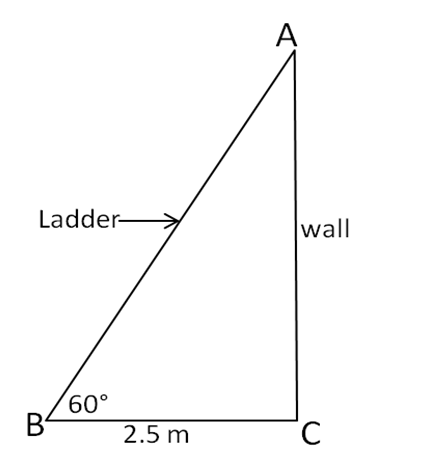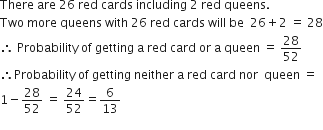CBSE mathematics
Sponsor Area
In Fig. , PQ is tangent at point C to a circle with centre O. If AB is a diameter and ∠CAB = 30°, find ∠PCA.
In the given figure,
In Δ ACO,
OA=OC (Radii of the same circle)
Therefore,
ΔACO is an isosceles triangle.
∠CAB = 30° (Given)
∠CAO = ∠ACO = 30° (angles opposite to equal sides of an isosceles triangle are equal)
∠PCO = 90° …(radius is drawn at the point of
contact is perpendicular to the tangent)
Now ∠PCA = ∠PCO – ∠CAO
Therefore,
∠PCA = 90° – 30° = 60°
Sponsor Area
For what value of k will k+9, 2k-1 and 2k+7 are the consecutive terms of an A.P?
If k+9, 2k-1 and 2k+7 are the consecutive terms of A.P, then the common difference will be the same.
∴ (2k – 1) – (k + 9) = (2k + 7) – (2k – 1)
∴ k – 10 = 8
∴ k = 18
A ladder leaning against a wall makes an angle of 60° with the horizontal. If the foot of the ladder is 2.5 m away from the wall, find the length of the ladder.
Let AB be the ladder and CA be the wall.
 The ladder makes an angle of 60o with the horizontal.
The ladder makes an angle of 60o with the horizontal.∴ ΔABC is a 30o-60o-90o, right triangle.
Given: BC = 2.5 m, ∠ABC = 60°
AB = 5 cm and ∠BAC = 30°
From Pythagoras Theorem, we have
AB2 = BC2 + CA2
52 = (2.5)2 + (CA)2
(CA)2 = 25 – 6.25 = 18.75 m
Hence, length of the ladder is ![]()
A card is drawn at random from a well -shuffled fled pack of 52 playing cards. Find the probability of getting neither a red card nor a queen.

1.
If -5 is a root of the quadratic equation 2x2 + px – 15 = 0 and the quadratic equation p(x2 + x)k = 0 has equal roots, find the value of k.
We Given -5 is a root of the quadratic equation 2x2+px-15 =0
, -5 satisfies the given equation.
∴ 2 (-5)2 +p(-5)-15=0
50-5p-15 =0
35-5p=0
5p=35 ⇒ p=7
Substituting p=7 in (x2+x)+k =0, we get
7(x2+x)+k =0
7x2+7x+k=0
The roots of the equation are equal
∴ Discriminant =b2-4ac =0
Here, a= 7, b=7,c=k
b2-4ac=0
∴(7)2-4(7)(k) =0
49-28k =0
28k=49
k= 49/28
=7/4
Sponsor Area
Mock Test Series
Mock Test Series





